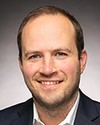Thank you.
We now go to you, Ms. Gray, for five minutes.
Evidence of meeting #15 for Industry, Science and Technology in the 44th Parliament, 1st session. (The original version is on Parliament’s site, as are the minutes.) The winning word was talent.
A recording is available from Parliament.
Liberal
Conservative

Tracy Gray Conservative Kelowna—Lake Country, BC
Thank you, Mr. Chair.
My first question is for Dr. Simmons. We've heard some shocking testimony today of how behind Canada is on the security issues around quantum computing and the security issues that they can pose.
My question is about quantum hacking of social media platforms and accessing people's personal information, messages, photos, and encrypted messaging apps. Are they all secure?
Founder and Chief Quantum Officer, Photonic Inc.
No.
The way encryption works right now is that there's an asymmetric layer and a symmetric layer. Everybody needs that asymmetric layer for the symmetric part to work. That's every communication we have on the Internet. It's the SWIFT banking system. It's how you send communications between government buildings. Everything relies on the fact that RSA is just really hard.... It has been shown to be the case that classical computers have not been able to get at it.
I don't want to be the one who.... Yes, I am trying to get attention to this issue because the risk of failure is so high. I think it's entirely plausible that these post-quantum algorithms will be successful. I would be over the moon because then it removes us from being seen as a cybersecurity threat, and then the technology gets to be enjoyed for all these wonderful things.
However, we have to get them in and it's going to take time. If it doesn't work and if these aren't sufficient, then we're in a real bind.
I just wanted to bring that to everyone's attention. I'm sorry to be the one to shock you all into being aware of this, but it is coming. I think it's perhaps hard to imagine the scale of the shift that needs to happen in time for this to come on.
Conservative

Tracy Gray Conservative Kelowna—Lake Country, BC
Great. Thank you.
What needs to be done to protect these platforms and all of the information that's on there?
Founder and Chief Quantum Officer, Photonic Inc.
I don't think there's anything we can do, using RSA, to protect the communications that are being stored right now by adversarial nations. All of that information is going to be openable to adversarial governments if they've stored it, and I know they have. There's really nothing we can do about that.
Nonetheless, we can start to protect all the communications going forward by layering in RSA and all of these other layers of defence.
I think we should go so far, especially for critical infrastructure like access to power grids and to nuclear facilities, for goodness sake. Anything that has access using RSA of course has additional infrastructure, but it is a weak point. The only thing that's been proven to block that is going to be a one-time pad or a QKD solution.
Fortunately, Canada is a global leader on QKD. I can't tell you how fantastic it is to be in a country that is leading the world on this. We have quantum satellites at IQC, and the invention thereof, which was mentioned before by Gilles Brassard We have the talent to do it, but we need to mobilize because it's not sufficient for the researchers to just say it needs to happen.
There's a lot of work to be done.
Conservative

Tracy Gray Conservative Kelowna—Lake Country, BC
For clarification, do you mean that if these were hacked and this information did become available, all of those messages that were stored in history or are considered encrypted and safe right now, and that we think won't be seen, could all be accessible at some point? Is that what you're saying today?
Founder and Chief Quantum Officer, Photonic Inc.
Yes, that's right.
We know that they've been storing messages for decades because they've known since 1995 that this is possible. It's just a matter of time.
Conservative

Tracy Gray Conservative Kelowna—Lake Country, BC
Wow.
In your best knowledge, are these platforms addressing this right now? Are they putting these different layerings in or is it part of their plans based on what you know?
Founder and Chief Quantum Officer, Photonic Inc.
I know that people are thinking about it, but I know that there's almost zero sense of urgency. I think that's a mistake.
Conservative

Tracy Gray Conservative Kelowna—Lake Country, BC
What do you think needs to be done right now? What steps could they be taking right now based on the technology that's available right now?
Founder and Chief Quantum Officer, Photonic Inc.
Thank you.
I think a lot of large organizations are wary of adopting standards that haven't been stress tested. NIST is coming through with a recommendation for post-quantum cryptography. It's rumoured that this will be coming through in the next few weeks or perhaps months.
I think that should be layered on top of RSA because it should be sufficient.... You have to at least have a quantum computer to break RSA, but you should also layer in all of those. For the most secure critical infrastructure, we should have a one-time pad solution. A one-time pad solution means loading up a lot of preloaded keys and actually physically distributing them between the locations we want to secure communications between.
I know that very few organizations are thinking about this. QKD is the other one, but that's a bigger infrastructure play. I think it deserves investment because that's absolutely the future, but it's going to take time. We're not going to be able to deploy it quickly enough before we need to secure our communications.
As I said, the communications that are happening today are being stored to be opened tomorrow.
Liberal

The Chair Liberal Joël Lightbound
Thank you very much, Dr. Simmons.
I'll move now to Mr. Erskine-Smith for five minutes.
Liberal

Nathaniel Erskine-Smith Liberal Beaches—East York, ON
Thanks, Joël.
For some clarity on procurement, I want to pick up on what may be a difference between the testimony given, but may not be.
My understanding from listening to Mr. Fursman is that much of the technology is akin to a “half fence” and doesn't have current value but will have future value.
Ms. Simmons, you've identified this need to procure today. How do I square those two ideas?
I'll start with Mr. Fursman and move to Ms. Simmons.
Co-Founder and Chief Executive Officer, 1QB Information Technologies Inc.
I think you've understood me exactly correctly.
My belief is that the government needs to understand that quantum computers today are not a better, faster, cheaper solution to any known problem in terms of their ability to actually deliver that, and yet we know that there are many areas where only quantum computers will likely be able to do this work in the future.
I think the real question is, without forcing a half fence on industry, how do we make sure that we are procuring in ways that recognize the current state, going into this with eyes open and saying that we need this work to happen over, say, the next decade? We also need to recognize that if you're using a quantum computer to do a solution today, you're not using the best available solution, so for studying how quantum computers work, this is very important, but to say that everyone should switch to quantum computers today is nonsense. It's impossible, and it's not something that's in line with the technology and the technological reality.
Liberal

Nathaniel Erskine-Smith Liberal Beaches—East York, ON
Thanks, Mr. Fursman.
Ms. Simmons, from the government's perspective, with the public dollars we could put into play in procurement, what is an example of something that you would like to see the government procure and that they are not procuring today in the quantum space?
Founder and Chief Quantum Officer, Photonic Inc.
Yes. The national quantum strategy just invested a third of the strategy into training, essentially. Why don't we have these quantum computers procured for that training purpose? Why are we not buying.... We are building fledgling airplanes, right? Yes, they don't cross the ocean yet, but we know where they're going. If we can support local industry, we can build more and more of these things and actually pay the salaries to keep the professionals here.
I completely agree with Andrew: These things do not move the commercial needle from a computational perspective yet, but we all know where these are going. We tend to overestimate the short term, but underestimate the long-term, applications of these things. This is commercializing a branch of physics. It's going to transform everything. If we give people hands-on training in these training organizations, then we don't need to rely so much upon industry for this detailed training.
I would add one more thing. There are quantum technologies that are useful today. QKD is one of them. It's only a short-distance...but it's provably secure. It's something that you can purchase. I think that one of the things the government could procure is a demonstration. You could procure the demonstration of a repeater. This is what DARPA does, right? They procure milestones on technological road maps. It's not a grant. It's actually a case of, “Can you procure this deliverable?” It makes a big difference to the ability to raise the capital necessary to actually keep the talent here, in Canadian organizations. They want to keep it.
Liberal

Nathaniel Erskine-Smith Liberal Beaches—East York, ON
You referenced commercialization. It seems to me that there's probably more to do with respect to training and retaining talent. The government seems to have identified that as a core priority in the course of the dollars it has spent so far.
In relation to the consultations so far in the “what we heard” report, I'll ask all of our witnesses this question—but I'd be interested in Ms. Schwartz's view to start with, then Ms. Simmons' and then Mr. Fursman's, if we have time.
There's this open question of how you best spend the public dollar. There are large organizations. There are.... You can make small bets on large organizations and a small or large number of bets on small organizations as they relate to commercialization. There's an open question in the “what we heard” report as to the way the government ought to pursue this. Do you have a view as to how the government should be spreading the rest of the money around in terms of commercialization in particular?
Vice-President, Global Government Relations and Public Affairs, D-Wave Systems Inc.
I appreciate the question. I've heard you raise that questions in previous hearings as well.
Many quantum computers, if not most of them, are available through the cloud. You're able to access the system and build the talent. You're able to identify areas of utilization of the technology today in a quantum hybrid format, as I talked about. That is also an area that's helping these smaller start-ups get their systems ready and available through a cloud.
If there were a domestic high-performance computing centre integrated with quantum, you could have some quantum systems there, and in a variety of sizes. Maybe some of them are the smaller ones that are really looked at just for research, and others could be commercial-sized ones and navigate through that.
From the government's perspective, I don't think it's an “or”. I think it's an “and” in terms of actually looking at how we navigate to get these different systems up to a level. Once they're already there, how do we push them for their technology readiness to push them into a mature market?
Liberal

The Chair Liberal Joël Lightbound
Thank you, Ms. Schwartz and Mr. Erskine-Smith.
Thanks to all of our witnesses.
That's all of the time we have. It was a very interesting discussion. I'm sure it was eye-opening to many listening and to my colleagues here at the committee.
I'll also take a brief moment because I know that last week PM Kram had questions on quantum as it pertains to crypto. There was an interesting discussion that I quite enjoyed a few months back with Mr. Fursman on Preston Pysh's investorpodcast.com. If you want to learn more about quantum as it pertains to encryption in the financial sector, that was a very interesting discussion.
Thank you, Mr. Fursman. While we have you here, I wanted to thank you for that.
I wish all of the witnesses and all members a great weekend. Thanks to the analysts, the interpreters and the clerk.
This meeting is adjourned.